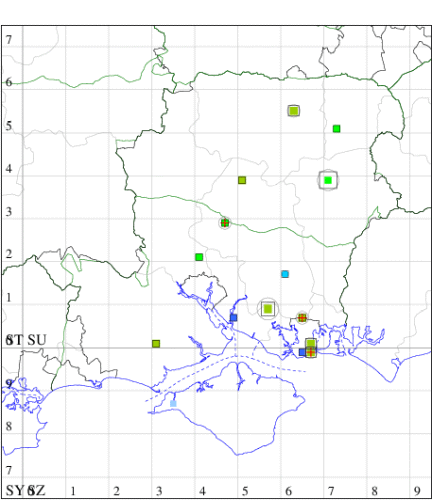Cnephasia pasiuana
Checklist Number49.052 [B&F: 1022]
Verification
Record requires retention of specimen until confirmed, and may require dissection. Consult with CMR if unsure
Classification
| Family: | Tortricidae |
| Subfamily: | Tortricinae |
| Genus: | Cnephasia |
| Species: | pasiuana |
| Authority: | (Hübner, [1799]) |
Local in gardens, woodland edges and other open areas throughout much of England, but rarer in the north; old records for Ireland, Wales and Scotland should be treated with caution. In Hampshire and on the Isle of Wight there has been an increase in the number of records received in the first decade of this century, almost certainly due to an increase in critical examination of specimens. However, the discovery that the closely related C. pumicana exists in Britain makes the verification of the true distribution of pasiuana in the county difficult and will require the re-evaluation of all historic records. Wingspan 15-20 mm. The obscure grey forewing pattern varying from pale to dark - most often pale - makes confirmed identification on external characteristics impossible, as it is indistinguishable from the closely related C. pumicana (recently added to the British list) and for pale specimens, from C. genitalana, and records can therefore only be accepted based on dissection of the genitalia. Larva feeds within flowerheads of various herbaceous plants, living between flowers spun together with silk.


The abundance in each month is indicated as follows:
 No records
No records Very occasional
Very occasional Irregular
Irregular Uncommon
Uncommon Off-peak, but not unusual
Off-peak, but not unusual Off-peak, but not unusual
Off-peak, but not unusual Main flight time
Main flight time| J | F | M | A | M | J | J | A | S | O | N | D | |
|---|---|---|---|---|---|---|---|---|---|---|---|---|
| Adult |  |  |  |  |  |  |  |  |  |  |  |  |
| Larval |  |  |  |  |  |  |  |  |  |  |  |  |
Records by week (adult)
Records by week (larval)
VC10 Isle of Wight
| Site | Date | Quantity | Recorder | Stage |
|---|---|---|---|---|
| Freshwater (SZ38) | 1923 | - | W Fassnidge | Adult |
VC11 South Hampshire
| Site | Date | Quantity | Recorder | Stage |
|---|---|---|---|---|
| Teg Down, Winchester (SU42) | 08/06/1980 | - | J R Langmaid, D H Sterling | Larval |
| Soberton (SU61) | 13/07/1985 | one | J R Langmaid, E C Pelham-Clinton | Adult |
| Hamble Common (SU40) | 21/06/1993 | one | Richard J Dickson | Adult |
| Portsmouth (SU60) | 15/07/1999 | one | Ian Thirlwell | Adult |
| Southsea (SZ69) | 15/07/1999 | one | John R Langmaid | Adult |
| Chandlers Ford (SU42) | 16/07/2001 | one | Brian Elliott | Adult |
| Winchester (SU42) | 26/06/2007 | one | Tim Walker | Adult |
| Funtley (SU50) | 25/07/2010 | one | Maurice Opie | Adult |
| Roydon Woods HIWWT NR, NF (SU30) | 26/07/2010 | one | Richard J Dickson | Adult |
| Portsdown (SU60) | 23/05/2011 | one | J R Langmaid, D J L Agassiz | Larval |
| Funtley (SU50) | 11/07/2011 | one | Maurice Opie | Adult |
| Funtley (SU50) | 26/07/2012 | one | Maurice Opie | Adult |
| Portsmouth (SU60) | 27/07/2012 | one | Ian Thirlwell | Adult |
| Eastney (SZ69) | 14/06/2016 | one | J R Langmaid, R J Dickson, I R Thirlwell | Larval |
| Eastney (SZ69) | 14/06/2016 | one | John R Langmaid | Larval |
| Portsdown (SU60) | 04/06/2017 | - | J R Langmaid, M R Young, I R Thirlwell | Larval |
VC12 North Hampshire
| Site | Date | Quantity | Recorder | Stage |
|---|---|---|---|---|
| Greywell (SU75) | 23/07/2004 | one | Paul Boswell | Adult |
| Sherborne St John (SU65) | 01/08/2005 | one | Nick Montegriffo | Adult |
| Alton (SU73) | 05/07/2007 | two | Dave Owen | Adult |
| Alton (SU73) | 05/07/2007 | two | Dave Owen | Adult |
| Alton (SU73) | 27/08/2008 | one | Dave Owen | Adult |
| Weston Colley (SU53) | 08/07/2010 | one | David G Green | Adult |
| Sherborne St John (SU65) | 16/07/2015 | one | Nick Montegriffo | Adult |
| Magdalen Hill Down NNR (SU52) | 02/06/2025 | one | Marcus Charig | Adult |
.jpg)
.jpg)